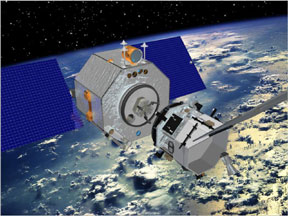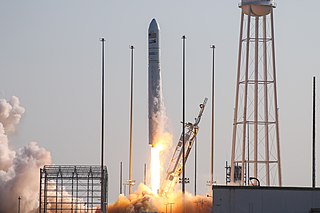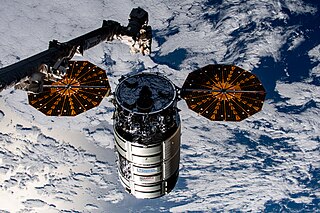
SSL, formerly Space Systems/Loral, LLC (SS/L), of Palo Alto, California, is a wholly owned manufacturing subsidiary of Maxar Technologies.

Landsat 7 is the seventh satellite of the Landsat program. Launched on 15 April 1999, Landsat 7's primary goal is to refresh the global archive of satellite photos, providing up-to-date and cloud-free images. The Landsat program is managed and operated by the United States Geological Survey, and data from Landsat 7 is collected and distributed by the USGS. The NASA WorldWind project allows 3D images from Landsat 7 and other sources to be freely navigated and viewed from any angle. The satellite's companion, Earth Observing-1, trailed by one minute and followed the same orbital characteristics, but in 2011 its fuel was depleted and EO-1's orbit began to degrade. Landsat 7 was built by Lockheed Martin Space Systems.
Orbital Sciences Corporation was an American company specializing in the design, manufacture, and launch of small- and medium- class space and launch vehicle systems for commercial, military and other government customers. In 2014, Orbital merged with Alliant Techsystems (ATK) to create a new company called Orbital ATK, which in turn was purchased by Northrop Grumman in 2018.

Orbital Express was a space mission managed by the United States Defense Advanced Research Projects Agency (DARPA) and a team led by engineers at NASA's Marshall Space Flight Center (MSFC). The Orbital Express program was aimed at developing "a safe and cost-effective approach to autonomously service satellites in orbit". The system consisted of two spacecraft: the ASTRO servicing satellite, and a prototype modular next-generation serviceable satellite; NEXTSat. The mission launched from Cape Canaveral Air Force Station on 8 March 2007, aboard an Atlas V expendable launch vehicle. The launch was part of the United States Air Force Space Test Program STP-1 mission.
IndoStar-1, also known as Cakrawarta-1, was a communication satellite that was launched the evening of November 12, 1997 at 21:48 GMT aboard an Ariane 44L-3 rocket from Kourou, French Guiana. As the first direct broadcasting satellite (DBS) in Asia, IndoStar-1 would initiate a new communication service for Indonesian society such as direct-to-home television.
The STAR-2 Bus is a fully redundant, flight-proven, spacecraft bus designed for geosynchronous missions.

Cygnus is an expendable American automated cargo spacecraft designed for International Space Station (ISS) resupply missions. It was initially developed by Orbital Sciences Corporation with financial support from NASA under the Commercial Orbital Transportation Services (COTS) program. To create Cygnus, Orbital paired a pressurized cargo module, largely based on the Multi-Purpose Logistics Module, built by Thales Alenia Space and previously used by the Space Shuttle for ISS resupply, with a service module based on Orbital's GEOStar, a satellite bus. After a successful demonstration flight in 2013, Orbital was chosen to receive a Commercial Resupply Services (CRS) contract. A larger Enhanced Cygnus was introduced in 2015. Orbital Sciences merged into Orbital ATK in 2015; Northrop Grumman purchased Orbital ATK in 2018 and has continued to operate Cygnus missions. A further enlarged Mission B Cygnus is expected to be introduced in 2025.
Space Infrastructure Servicing (SIS) is a spacecraft concept being developed by Canadian aerospace firm MDA to operate as a small-scale in-space refueling depot for communication satellites in geosynchronous orbit.
The Mission Extension Vehicle (MEV) is a spacecraft that extends the functional lifetime of another spacecraft through on-orbit satellite servicing. They are 2010s-design small-scale in-space satellite-refueling spacecraft first launched in 2019. The MEV spacecraft grew out of a concept proposed in 2011 by ViviSat, a 50/50 joint venture of aerospace firms US Space and Alliant Techsystems (ATK). The joint venture was created in 2010 for the purpose of designing, producing and operating the MEV program.

A space tug is a type of spacecraft used to transfer spaceborne cargo from one orbit to another orbit with different energy characteristics. The term can include expendable upper stages or spacecraft that are not necessarily a part of their launch vehicle. However, it can also refer to a spacecraft that transports payload already in space to another location in outer space, such as in the Space Transportation System concept. An example would be moving a spacecraft from a low Earth orbit (LEO) to a higher-energy orbit like a geostationary transfer orbit, a lunar transfer, or an escape trajectory.

The Robotic Refueling Mission (RRM) is a NASA technology demonstration mission with equipment launches in both 2011 and 2013 to increase the technological maturity of in-space rocket propellant transfer technology by testing a wide variety of potential propellant transfer hardware, of both new and existing satellite designs.
On-orbit satellite servicing refers to refueling or repairing space satellites while in orbit.
On-Orbit Servicing, Assembly, and Manufacturing 2 (OSAM-2), formally known as Archinaut, was a technology demonstration project aimed at developing the necessary additive manufacturing technology to build large-scale structures in space. Phase 1 of the project started in 2016 and was funded by a NASA contract worth US$20 million; it was performed by a partnership between Made In Space (MIS), Northrop Grumman, and Oceaneering Space Systems. Its formal name was "Versatile In-Space Robotic Precision Manufacturing and Assembly System".
Intelsat 10-02 is a communications satellite operated by Intelsat. Intelsat 10-02 is the first operational communications satellite to have its service life extended by Mission Extension Vehicle-2, while still in service, in 2021.

RSat-P is a microsatellite built by the United States Naval Academy (USNA) in Annapolis, Maryland. The small spacecraft is a 3U CubeSat intended to demonstrate capabilities for minor in-orbit repair of a much larger, conventional spacecraft.

NG-16, previously known as OA-16, was the sixteenth flight of the Northrop Grumman robotic resupply spacecraft Cygnus and its fifteenth flight to the International Space Station (ISS) under the Commercial Resupply Services (CRS-2) contract with NASA. The mission was launched on 10 August 2021 at 22:01:05 UTC, for a (planned) 90-day mission at the ISS. This was the fifth launch of Cygnus under the CRS-2 contract.

NG-18 was the eighteenth flight of the Northrop Grumman robotic resupply spacecraft Cygnus and its seventeenth flight to the International Space Station (ISS) under the Commercial Resupply Services (CRS-2) contract with NASA. The mission successfully launched on 7 November 2022 at 10:32:42 UTC. This was the seventh launch of Cygnus under the CRS-2 contract.

NG-19 was the nineteenth flight of the Northrop Grumman robotic resupply spacecraft Cygnus and its eighteenth flight to the International Space Station (ISS) under the Commercial Resupply Services (CRS-2) contract with NASA. The mission launched on 2 August 2023 at 00:31:14 UTC. This was the eighth launch of Cygnus under the CRS-2 contract.
Satellite refuelling is the operation of replenishing on board propellants and other consumables in satellites in orbit, e.g. in geostationary orbit around Earth.
OSAM-1 was a 2016-2024 conceptual NASA mission and spacecraft designed to test on-orbit refilling of satellites. The program was cancelled in 2024, two years ahead of its planned launch date. It was initially known as Restore-L.










